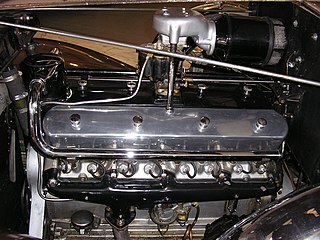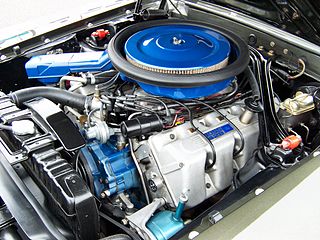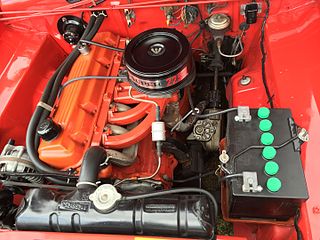Related Research Articles

A V12 engine is a twelve-cylinder piston engine where two banks of six cylinders are arranged in a V configuration around a common crankshaft. V12 engines are more common than V10 engines. However, they are less common than V8 engines.

A V16 engine is a sixteen-cylinder piston engine where two banks of eight cylinders are arranged in a V configuration around a common crankshaft. V16 engines are less common than engines with fewer cylinders, such as V8 and V12 engines. Each bank of a V16 engine can be thought of as a straight-8, a design that can be inherently balanced. Most V16 engines have a 45° bank angle.

A straight-four engine is a four-cylinder piston engine where cylinders are arranged in a line along a common crankshaft.

The inline-six engine is a piston engine with six cylinders arranged in a straight line along the crankshaft. A straight-six engine has perfect primary and secondary engine balance, resulting in fewer vibrations than other designs of six or fewer cylinders.

The Ford 385 engine family is a series of big-block V8 engines designed and manufactured by Ford Motor Company. The family derives its name from the 3.85-inch (98 mm) crankshaft stroke of the 460 cubic-inch V8 introduced in 1968. A 429 cu in (7.0 L) version was also introduced the same year, with a 370 cu in (6.1 L) variant appearing in 1977.

The Ford small-block is a series of 90° overhead valve small-block V8 automobile engines manufactured by the Ford Motor Company from July 1961 to December 2000.

The Slant-Six is the popular name for a Chrysler inline-6 internal combustion engine with an overhead valve reverse-flow cylinder head and cylinder bank inclined at a 30-degree angle from vertical. Introduced in 1959 for the 1960 models, it was known within Chrysler as the G-engine. It was a clean-sheet design that began production in 1959 at 170 cubic inches (2.8 L) and ended in 2000 at 225 cubic inches (3.7 L). It was a direct replacement for the flathead Chrysler straight six that the company started business with in 1925 until the old design was discontinued in the 1960s.

The Rover V8 engine is a compact V8 internal combustion engine with aluminium cylinder block and cylinder heads, originally designed by General Motors and later re-designed and produced by Rover in the United Kingdom. It has been used in a wide range of vehicles from Rover and other manufacturers since its British debut in 1967.
The Ford Motor Company produced straight-six engines from 1906 until 1908 and from 1941 until 2016. In 1906, the first Ford straight-six was introduced in the Model K. The next was introduced in the 1941 Ford. Ford continued producing straight-six engines for use in its North American vehicles until 1996, when they were discontinued in favor of more compact V6 designs.

GMC has both shared engine designs and architectures with other General Motors divisions as well as having a history of developing and using its own unique engines and powertrains such as for instance its line of their straight-6 and V8 engines.

The Cummins B Series is a family of diesel engines produced by American manufacturer Cummins. In production since 1984, the B series engine family is intended for multiple applications on and off-highway, light-duty, and medium-duty. In the automotive industry, it is best known for its use in school buses, public service buses in the United Kingdom, and Dodge/Ram pickup trucks.

The Chevrolet Opala is a Brazilian mid-size car sold under the Chevrolet brand in South America from 1969 to 1992, by General Motors do Brasil. It was derived from the German Opel Rekord Series C, Opel Commodore Series A, but used local design styling and engines derived from North American designs. GM manufactured about one million units including the Opala sedan, Opala Coupé, and the station wagon variant, the Opala Caravan. It was replaced by the Chevrolet Omega in 1992, also an Opel spinoff. It was the first passenger car built by GM in Brazil by the General Motors do Brasil division. A luxury version of the Opala was marketed as the Chevrolet Diplomata.
The Ford Super Duty engine is a range of V8 engines that were manufactured by Ford Motor Company. Introduced in 1958, the Super Duty engines replaced the Lincoln Y-block V8.

The Detroit Diesel Series 71 is a two-stroke diesel engine series, available in both inline and V configurations, manufactured by Detroit Diesel. The number 71 refers to the nominal displacement per cylinder in cubic inches, a rounding off of 70.93 cu in (1.2 L).

A V8 engine is an eight-cylinder piston engine in which two banks of four cylinders share a common crankshaft and are arranged in a V configuration.
The Detroit Diesel Series 110, with 110 cubic inches (1.8 L) displacement per cylinder, was introduced in 1945 as more-powerful alternative to the existing Series 71 engines. It was used in a variety of applications, including construction equipment, marine propulsion and power generation. The most popular use was in the Budd RDC self-powered rail car. It was also heavily used in Euclid construction machinery. In 1951 a marine version was also introduced.

The International Harvester IDI engine is a four-stroke diesel V8 engine used in International Harvester school buses, trucks, Ford F-Series pickups, and Ford E-Series vans from the 1983 to 1994 model years. The engine was built in two displacements: 420 cubic inches (6.9 L), which was used in Ford trucks from 1983 until 1987, and 444 cubic inches (7.3 L), which was used in Ford trucks from 1988 until 1994 and in 1993 and 1994 (turbocharged).
References
- ↑ Diesel engines ESD-442, ESD-659, ESD-660T, ESD-662: Service Manual (PDF) (Manual), Ford Power Products, November 1983, pp. 1–03, 8–01, PPO 194-243
- ↑ "Tech Tip #92: Identifying the Ford Dover and Dorset Engines". Worcester, MA: Foley Marine & Industrial Engines, Inc. April 19, 2008. Retrieved 2015-04-04.
- ↑ Kennett, Pat, ed. (September 1983). "Truckmonth: Ford van diesel". TRUCK. London, UK: FF Publishing Ltd: 18.